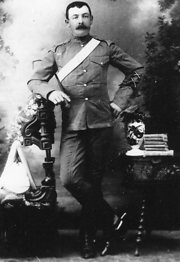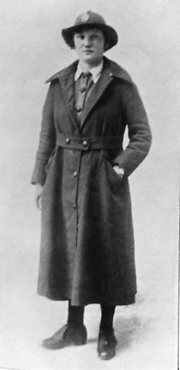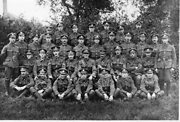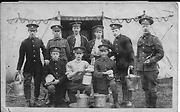 Hartlepool Sports & Leisure
Hartlepool Sports & Leisure
- Cinemas, Theatres & Dance Halls
- Musicians & Bands
- At the Seaside
- Parks & Gardens
- Caravans & Camping
- Sport
 Hartlepool Transport
Hartlepool Transport
- Airfields & Aircraft
- Railways
- Buses & Commercial Vehicles
- Cars & Motorbikes
- The Ferry
- Horse drawn vehicles
 A Potted History Of Hartlepool
A Potted History Of Hartlepool
- Unidentified images
- Sources of information
- Archaeology & Ancient History
- Local Government
- Printed Notices & Papers
- Aerial Photographs
- Events, Visitors & VIPs
 Hartlepool Trade & Industry
Hartlepool Trade & Industry
- Trade Fairs
- Local businesses
- Iron & Steel
- Shops & Shopping
- Fishing industry
- Farming & Rural Landscape
- Pubs, Clubs & Hotels
 Hartlepool Health & Education
Hartlepool Health & Education
- Schools & Colleges
- Hospitals & Workhouses
- Public Health & Utilities
- Ambulance Service
- Police Services
- Fire Services
 Hartlepool People
Hartlepool People
 Hartlepool Places
Hartlepool Places
 Hartlepool at War
Hartlepool at War
 Hartlepool Ships & Shipping
Hartlepool Ships & Shipping

The Army - First World War
Details about The Army - First World War
Army service personnel during the First World War.
Location
Related items () :
 'Somewhere in France'
'Somewhere in France'
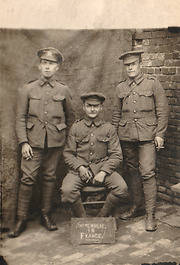 Donated by Pauline Watson
Donated by Pauline WatsonThe image shows Walter Parkinson centre and two colleagues in WW1
More detail » 1917 - the Rice family
1917 - the Rice family
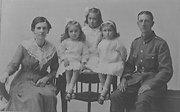 Donated by Mr. John Watson
Donated by Mr. John WatsonDated 1917
A 1917 family photograph of Jack and Ethel Rice, with their three children Olive, Evelyn and Peggy. Jack was gassed during the war.
More detail » 28 Days Furlough
28 Days Furlough
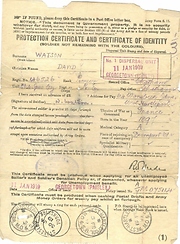 Donated by Mr. J. Watson
Donated by Mr. J. WatsonDated 1919
David Watson on Army leave in the early part of 1919.
More detail » A First World War Will
A First World War Will
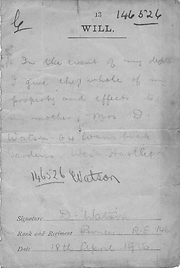 Donated by Mr. John Watson
Donated by Mr. John WatsonDated 1916
A brief, First World War soldier's Will, written in pencil, on 18th April, 1916.
More detail » A trio in uniform
A trio in uniform
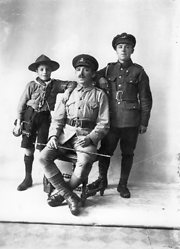 Donated by Hartlepool Library Service
Donated by Hartlepool Library ServiceSoldier sat down with another sodier to his left and a boy scout to his right. Possibly a family photograph.
HHT&N 545
More detail » An Officer and N.C.Os.
An Officer and N.C.Os.
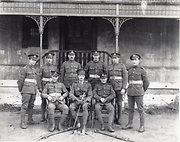 Donated by Hartlepool Library Service
Donated by Hartlepool Library ServiceAn Officer and N.C.Os. outside a building which could be the Staincliffe Hotel.
HHT&N 529
More detail » Army Pass
Army Pass
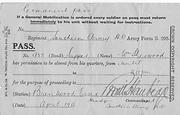 Donated by Frank Sherwood
Donated by Frank SherwoodAn Army Pass issued to William Sherwood from Hartlepool during the first world war.
More detail » At Wharncliffe War Hospital (1)
At Wharncliffe War Hospital (1)
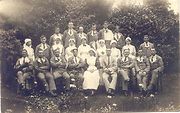 Donated by Mr. Keith Bloomfield
Donated by Mr. Keith BloomfieldDated 1915
James Arthur Bloomfield (front row sitting 3rd from right), with other patients and nurses at Wharncliffe War Hospital Sheffield, July 1915. Read more about James' war service in the Note James Arthur Bloomfield: War Service 1914-16.
More detail » At Wharncliffe War Hospital (2)
At Wharncliffe War Hospital (2)
 Donated by Mr. Keith Bloomfield
Donated by Mr. Keith BloomfieldDated 1915
Another photograph of James Arthur Bloomfield (sitting in the chair on the extreme right), with other patients and nurses at Wharncliffe War Hospital Sheffield, July 1915. Read more about James' war service in the NoteJames Arthur Bloomfield: War Service 1914-16.
More detail » Charles Robson and Billie Gibbin
Charles Robson and Billie Gibbin
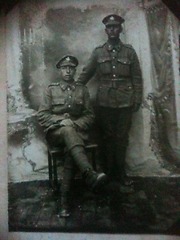 Created by unknown
Donated by Mrs. Stephanie Bone
Created by unknown
Donated by Mrs. Stephanie BoneA photograph of Charles Robson and Billie Gibbin (unfortunately we are not sure which is which), who were both killed during the war. Charles (Charlie), was killed on 2 October 1918, age 21 and 10 months, and is buried in Lijssenthoek Cemetery. He was the son of Charles & Betsy Robson (nee Holmes). Billie Gibbin was probably only 15 years old when he signed-up, but was killed on December 16th, 1915 just a couple of months before his 16th birthday. Their service numbers are consecutive so presumably they signed up in a Pals regiment together.
More detail » Colonel Robson
Colonel Robson
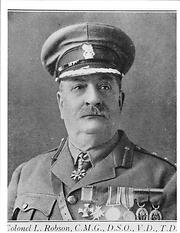 Part of the Library collection
Part of the Library collectionColonel Robson was highly decorated and when King George V visited the town in June 1917, he was honoured by him with a CMG
HHT&N 535
More detail » Durham Royal Garrison Artllery
Durham Royal Garrison Artllery
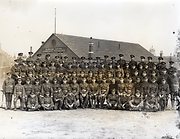 Donated by Hartlepool Library Service
Donated by Hartlepool Library ServiceA unit of soldiers photographed outside the Durham Royal Garrison Artillery premises. The tower of the Cetral Co-op building can be seen on the right.
HHT&N 534
More detail » Emil Casper (3)
Emil Casper (3)
 Created by unknown
Donated by Mr. Mark Stone
Created by unknown
Donated by Mr. Mark StoneDated 1914
Emil Casper (back row, second from the right), photographed with other officers from the Territaorial Battery, circa. 1914.
More detail » Ernie London
Ernie London
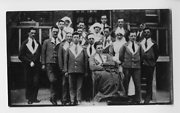 Part of the Hartlepool Museum Service collection
Part of the Hartlepool Museum Service collectionDated 1918
Reverse says 'Uncle Ernie London' taken prisoner and invalided 1918. Location unclear.
More detail » First World War Soldiers (1)
First World War Soldiers (1)
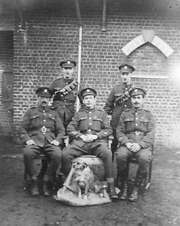 Donated by Mr. John Watson
Donated by Mr. John WatsonA group of five soldiers, with Charlie Watson (born 2nd May, 1892), in the centre.
More detail » First World War Soldiers (2)
First World War Soldiers (2)
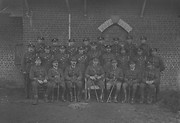 Donated by Mr. John Watson
Donated by Mr. John WatsonA larger group of Officers and men, with Sergeant Charlie Watson seated in the front row, extreme right.
More detail » Five Brothers
Five Brothers
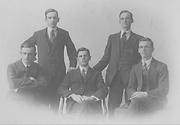 Donated by Mr. John Watson
Donated by Mr. John WatsonDated 1919
The Watson brothers photographed just after the First World War in which all five served and miraculously survived!
More detail » Fourth Yorkshire Regiment
Fourth Yorkshire Regiment
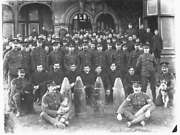 Donated by Douglas Ferriday
Donated by Douglas FerridayPart of the Hartlepool Library Service collection
Dated 1914
The men of the Fourth Yorkshire Regiment (Green Howards) outside the Staincliffe Hotel, Seaton Carew, with the two regimental dogs and six German shells discovered after the bombardment of Hartlepool in 1914.
More detail » George Clarke in Salonika
George Clarke in Salonika
 Donated by Frances Wilson
Donated by Frances WilsonDated 1917
Taken in August 1917 in Salonika Greece, George Clarke was in the DLI
More detail » Greetings Card
Greetings Card
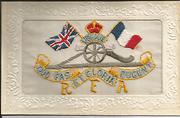 Donated by Jacky Armstrong
Donated by Jacky ArmstrongSent home from France by Samuel Bolton in DLI
More detail » Heugh Battery Garrison Soldiers
Heugh Battery Garrison Soldiers
 Donated by Jacky Armstrong
Donated by Jacky ArmstrongA group of four soldiers, probably part of the Heugh Battery Garrison.
More detail » In and out of uniform
In and out of uniform
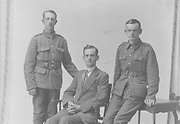 Donated by Mr. John Watson
Donated by Mr. John WatsonA formal photograph of (left to right), Jack Rice, James and David Watson.
More detail » Infantry Officers with unexpoded shells
Infantry Officers with unexpoded shells
 Donated by Douglas Ferriday
Donated by Douglas FerridayPart of the Hartlepool Library Service collection
Infantry Officers and sergeants outside the Staincliffe Hotel with unexploded shells from the bombardment.
More detail » J.S.A. Bunting M.C.
J.S.A. Bunting M.C.
This is the career of John (Jack) Bunting told in his own words and in those of his nephew, Derek Bunting. The attitudes and opinions expressed in this account are those of a different era.
John Shepherd Allison Bunting was born on 12th May 1898 in Seaton Carew, near Hartlepool, on the coast of County Durham. He was the youngest of four children of Charles John Bunting, a Hartlepool solicitor.
Jack, as he was always known, went to the High School in Hartlepool from 1908 till 1912 before going to Kings College, London University until 1915 with a view to a career in the Civil Service. But the Great War interviened. He tried to enlist in the Army when just 16 but a family friend, Sir Neville Gunter, who was then commanding the 3rd Battalion of the Yorkshire Regiment (The Green Howards) thought he was officer material and got him entered for Sandhurst. Jack was commissioned from there direct into Gunter's regiment on 25th September 1915, aged just 17.
2nd Lieutenant Jack Bunting went to France with his regiment in July 1916 to Armentieres. He was wounded in September 1916 in the first ever tank attack at Martinpuich - Flers Ridge at the Battle of the Somme and was sent home for convalescence. He returned to the Front on his 19th birthday in May 1917, spending the following winter in the Ypres salient. In July 1917, aged just 19, as a Lieutenant he commanded a Company of the 2nd Battallion Green Howards in their first wave of the attack on Bodmin Copse when they went over the top from the tip of the Ypres Salient.
As Lieutenant (acting Captain) he commanded a company of the 2nd Battalion at Roupy when the Germans counterattacked on 21st March 1918. The Green Howards were then forced to take part in the retreat of the British 5th Army and the Green Howards were defending the main road south of St Quentin and suffering heavy casualties. He was awarded an MC for which his citation reads:
"For conspicuous gallantry and devotion to duty. When in command of a company he resisted for 24 hours repeated attacks of the enemy, inflicting great losses on them. In the rearguard action on subsequent days he rallied his men with skill and courage until finally wounded."
He was wounded by machine gun fire on 28th March 1918. The bullet went clean through his thigh.
After being in hospital in England, as soon as he was passed fit he returned to France. He said later "I was young and healed very rapidly". He then commanded a Company of the 2nd Battalion Green Howards and led his men over the top on 2nd November 1918. He continued attacking until orders were recieved to halt hostilities when about 12 miles south of Mons on the French - Belgian border. He later wrote about this attack "On November 6th, when trying to cross a small river, the Germans opened up with heavy machine gun and rifle fire and the Company ahead of us was practically annihilated - all the officers killed or missing. After 9 days continuous attack in foul weather and no rations except the roots we scrounged from the fields and the little we carried, we were in a terrible state. The Bosche had destroyed bridges as they retreated and no cookers or transport of any kind could catch up with us. Some of the men had to have their boots cut off, so swollen were their feet."
Captain Jack Bunting was in charge of the Guard of Honour when Admiral Sir David Beatty, in command of the Grand Fleet, toured the battlefields after the end of hostilities. The Regimental Colours had by then arrived from England with the Regimental Band. He celebrated his 21st birthday party at the Officers' Club in Valenciennes on 12th May 1919. He later brought back the transport of the Battalion to their Regimental Headquarters in Richmond, North Yorkshire, via Dunkirk.
Jack's elder brother was my father Charles Gilbert Bunting and he also had two sisters; Kathleen (or Kit), who married Arnold Jones, a Director of Gray's shipyard, who lived in Hartlepool. They had one son, Dall. His other sister, Beatrice (or Bea) married Pier Rosling, who was General Manager of Henleys Telegraph Co and lived in Farnham, Surrey. Jack went to Buckingham Palace to be presented with his Military Cross by King George V. He was accompanied to the Palace by his mother and both his sisters.
Jack was very fortunate to survive. The Ypres Salient was defended by Commonwealth forces throughout the War. No less than 185,000 lives were lost there. I visited the Menin Gate in Ypres last year. This memorial commemorates 54,000 officers and men from the UK, Canada, Australia, India and South Africa who had died by 1916. I also went to the beautifully kept Tyne Cot cemetery where a further 35,000 are remembered. Over 40,000 of them were never identified but have headstones. 100,000 have no known grave.
After the War Jack was asked for his comments by the Royal Military Academy at Sandhurst. These were some of his replies:
I liked and admired the Regular Officers and I was accepted for a regular commission but resigned in 1920 having doubts about peacetime soldiering.
I think nearly all of us had the utmost contempt for anyone not prepared to fight for their kith and kin and their country no matter what reasons they might give. Life was pretty cheap to us and I think most of us would have approved of them being shot as traitors.
We were in a hurry in 1914 to get into the army in case the war was over before we could do our bit but I certainly do not think we ever contemplated a long war of attrition.
It was certainly very frightening at times and darned uncomfortable - sometimes one felt it would never end and one could become very depressed. The cheerful sense of Regimental camaraderie kept one going.
The New Zealand troops were fine soldiers. I thought the French were poor, dirty, undisciplined and totally unreliable.
After the War Jack joined Henleys Cables and became Sales Manager. He joined AEI in 1946 and became Managing Director of Edison Swan Cables. After the merger with Siemens he became Joint General Manager of the cable division of this very large public company. Oliver Lyttleton MP and Colonial Secretary, who became Lord Chandos, was Chairman of the company. Jack became Chairman of the Cable Makers Association. He was a member of the Grand Council of the Federation of British Industries. He retired from the Board of Associated Electrical Industries in 1962, later becoming Chairman of the British Group of the International Cable Development Corporation.
He retired to his house at St Margarets Bay, on the White Cliffs close to Dover. He had married Gertrude in 1930 and they had a son, the Reverend Jeremy John Bunting, born 1934, who went to school at Tonbridge and then to Cambridge University.
Jack played rugby and soccer for the 4th Army in France. After the War he played cricket for Hampstead, rugby for Richmond, soccer for the Casuals and golf at The Wildernesse and Walmer and Kingsdown golf clubs in Kent.
My father, Charles Gilbert Bunting, Jack's elder brother, served as a Captain in the Royal Artillery in Hartlepool during the Great War. After the War he ran a very successful firm of solicitors in Hartlepool. He married Joyce Hopkinson in 1927 and they had three sons; Gerald, born 1928, Derek (your correspondent) born 1932 and Edward, born 1936.
My father died in 1967 aged 78. Jack's wife, Gertrude, died in 1968 and with both of them widowed and living on their own my mother and Jack decided to get married, which they did in 1971. They had 16 very happy years together living in Jack's house at St Margarets Bay in Kent which looks out from the top of the White Cliffs of Dover towards France. Jack died in March 1987 aged 88. He was buried in the Seaton Carew churchyard with his mother and father, brother and other members of the Bunting family.
After Jack died Joyce returned to rejoin her many old friends in Hartlepool in 1987 and died there in 1994 aged 88. She is also buried at Seaton Carew beside her two husbands.
Derek Bunting
April 2013
More detail »
 James Arthur Bloomfield
James Arthur Bloomfield
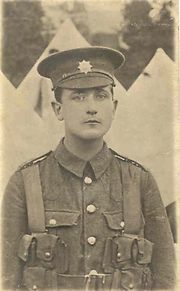 Donated by Mr. Keith Bloomfield
Donated by Mr. Keith BloomfieldDated 1914
A portrait of James Arthur Bloomfield, Coldstream Guards, in 1914.
More detail » James Arthur Bloomfield - Coldstream Guards (1)
James Arthur Bloomfield - Coldstream Guards (1)
 Donated by Mr. Keith Bloomfield
Donated by Mr. Keith BloomfieldDated 1915
James Arthur Bloomfield (sitting, front row, fourth from left), and the men of Corporal Sharpe's Squad, 14th Company, Coldstream Guards, photographed at Caterham 1914-15.
More detail » James Arthur Bloomfield - Coldstream Guards (2)
James Arthur Bloomfield - Coldstream Guards (2)
 Donated by Mr. Keith Bloomfield
Donated by Mr. Keith BloomfieldDated 1915
James Arthur Bloomfield (standing, 3rd from left, second row from the back), and the men of 14th Company, Coldstream Guards, photographed at Caterham 1914-15.
More detail » James Arthur Bloomfield - War Service 1914-16
James Arthur Bloomfield - War Service 1914-16
JAMES ARTHUR BLOOMFIELD: WAR SERVICE 1914-1916
Just after the First World War broke out in August 1914, James Arthur volunteered to serve in the Coldstream Guards and was enrolled on 1st September 1914, on which date his age was given as 18 years 1 day. He was, in fact, about six weeks short of his 18th birthday and, at the time, employed as a ‘lamp lad’ by the North Eastern Railway – “height 5ft.8 ¾ ins, weight 138 lb., complexion fresh, eyes blue, hair dark brown.” He was immediately sent to the Guards Depot at Caterham, Surrey and then to the 4th (Reserve) Battalion of the Coldstreams at Windsor as Private 11490, and for the next six months or so remained in training and on guard duties. On at least one occasion, whilst on guard duty at Windsor Castle, he told me that he had met King George V.
On 17th March 1915 he was posted to the 2nd Battalion of the Coldstreams serving in France as part of the ‘British Expeditionary Force Overseas’. He left Southampton that same day for Le Havre and, from there, the battalion made their way to the Front at Cuinchy. The next month they were moved to the Bethune area and to the front line at Festubert. On 20th May, after being in the trenches for only 24 hours, he was wounded in the foot, knee and arm whilst guiding a relieving party of the Black Watch to their positions near Rue du Bois (Choclat Menier Corner). The War Diary of the 2nd Battalion for that day is as follows:-
'Bn in Trenches.
At dark the Battalion was relieved in the Trenches by 1/6 Bn The Black Watch (Scottish Lowland Division)
Casualties 2 Other Ranks killed
12 Other Ranks wounded
These trenches were part of the position taken from the enemy on the 16th/17th May, and during the day were very heavily shelled by the enemy with every description of shell.
After relief the Battalion marched to Oblinghem and went into Billet arriving about 3 am on the 21st'
James' right foot was amputated at St. Omer and he returned to Dover on 22nd June. From there he was sent up to Wharncliffe War Hospital, Sheffield where there was a further amputation on 15th July followed by convalescence. His service with the B.E.F. amounted to 98 days. A small postcard addressed to a Mrs. Waters of Herstmonceux (sic), Sussex was found in James Arthur’s red Army Service Book; it gives a brief, first hand account of those 98 days.
An artificial limb was fitted at Wharncliffe on 18th March 1916 and James Arthur was discharged from the Army on 20th April 1916 – total military service 1 year 233 days. For his disability he received a pension of 25/- per week for the first two months and then 10/6-(52½ p) per week ‘for life’. This last was increased to £1 per week some time after the Second World War.
Some time after his return to England my father was offered a white feather by a woman passer-by who told him that he should be in France, like her son. He replied: 'in that case please ask him to look for my foot.'
It is interesting to note that James Arthur was very much a ‘growing boy’ during his Army service. When he joined at the age of 17 he was 5’ 8 ¾”; when he left nearly two years later he was 5’ 11”.
With an Army character reference as a “steady, hardworking man” he returned to civilian life at the age of 19 minus one leg and with no qualifications. By this time the Bloomfield family had moved to 18 Temperance Street and it was here that some of the family experienced the third Zeppelin bombing raid on West Hartlepool on 13th March 1918. 14 year-old sister Gladys was in the house with an older married cousin and they sheltered in the cupboard under the stairs The house was damaged and they were eventually rescued, very frightened but unharmed apart from a covering of soot and dust. They later said that the only parts of them not black were the white streaks down their faces where their tears had washed away the grime.
Keith Bloomfield.
More detail »
 John D Piper
John D Piper
 Donated by Hartlepool Museum Service
Donated by Hartlepool Museum ServiceWW1 Sergeant John D. Piper. Possibly this is the John D. Piper who was a motor engineer in Thornville Road according to Wards 1924 directory.
More detail » John George Hardy
John George Hardy
 Donated by Malcolm Hardy
Donated by Malcolm HardyJohn George Hardy, son of William Henry Hardy was born in Hartlepool in 1875 and died 1955 in Howbeck House, General Hospital. He is wearing the uniform of the Grenadier Guards in WW1.
More detail » Mentioned in Despatches
Mentioned in Despatches
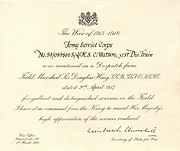 Donated by Mr. J. Watson
Donated by Mr. J. WatsonDated 1917
Quartermaster Sergeant C. Watson Mentioned in Despatches, 9th April, 1917.
More detail » Officers and N.C.Os.
Officers and N.C.Os.
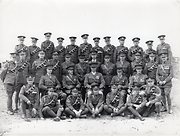 Donated by Hartlepool Library Service
Donated by Hartlepool Library ServiceOfficers and N.C.Os. from the Durham Royal Garrison Artillery during WW1. There appears to be sand dunes to the right.
HHT&N 526
More detail » Private Horsley - Certificate of Service
Private Horsley - Certificate of Service
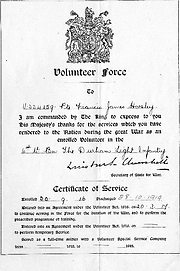 Created by F.J. Horsley
Donated by Hartlepool Library Service
Created by F.J. Horsley
Donated by Hartlepool Library ServiceDated 1919
Private Francis James Horsley's Certificate of Service with the Durham Light Infantry.
More detail » Private Robert Hodgson
Private Robert Hodgson
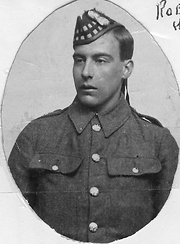 Donated by Mr. John Brooker
Donated by Mr. John BrookerA portrait of Private Robert Hodgson, who served with the 6th Royal Scots Fusiliers during the First World War. Wounded twice, in 1915 and 1916, Robert was killed in action in early May, 1917.
More detail » Private Robert Hodgson - 6th Royal Scots Fusiliers
Private Robert Hodgson - 6th Royal Scots Fusiliers
The following extracts are taken from the Northern Daily Mail:
18th August, 1915 - News has been received that Private Robert Hodgson, 6th Royal Scots Fusiliers, whose parents reside at 58 Hermit Street, Hartlepool, has been wounded, and is now in the Military Hospital, Rosset, near Wrexham.
9th August, 1916 - News has been received by Mr. & Mrs. Hodgson, of 58 Hermit Street, Hartlepool, that their son Private Robert Hodgson, of the Royal Scots Fusiliers, has been admitted into hospital at Lincoln, suffering from a gunshot wound in the right arm, this is the second time he has been wounded.
11th February, 1918 - Mr. & Mrs. Hodgson, of 58 Hermit Street, Hartlepool, have received official news that their son, Private R. Hodgson (23 years), Royal Scots Fusiliers, who was reported missing on May 3rd last year (1917), is now reported Killed. A message conveying the sympathy of the King and Queen has been received. Private Hodgson, who was employed at the Richardson, Westgarth Company's Works prior to joining the army when war broke out, had twice been wounded.
More detail » Richard Evers Corner and George Thomas Corner
Richard Evers Corner and George Thomas Corner
 Donated by Mrs.E.Robson
Donated by Mrs.E.RobsonMore detail »
 Samuel Bolton - Training Camp
Samuel Bolton - Training Camp
Three postcard photographs sent home by Samuel Bolton while training with the Durham Light Infantry. Two were sent from Morecambe to his father in Belmont Gardens in 1908; the other was sent to his wife in Worcester Street from the Barry Buddon Training Camp, near Carnoustie, Dundee.
More detail » Samuel Wilkinson Metcalfe
Samuel Wilkinson Metcalfe
 Donated by Mrs. Marion Bunn
Donated by Mrs. Marion BunnA portrait of Samuel Wilkinson Metcalfe in uniform, sometime during the First World War. Samuel served at the Battle of the Somme, and fortunately survived the war.
More detail » Samuel Wilkinson Metcalfe and pals
Samuel Wilkinson Metcalfe and pals
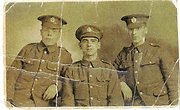 Donated by Mrs. Marion Bunn
Donated by Mrs. Marion BunnSamuel Wilkinson Metcalfe (centre), and two army pals. Samuel served with 225th Company, Royal Engineers. A short article about the 225th appears in the July 2009 edition (Vol.10, No.11), of the Cleveland, North Yorkshire & South Durham Family History Society Journal.
More detail » Soldiers from 4th Yorkshire Regiment
Soldiers from 4th Yorkshire Regiment
 Donated by Douglas Ferriday
Donated by Douglas FerridayPart of the Hartlepool Library Service collection
Soldiers from Fourth Yorkshire Regiment. Taken during the First World War possibly at the Heugh Gun Battery
More detail » The Palace Theatre
The Palace Theatre
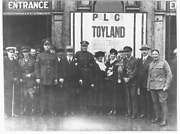 Donated by Douglas Ferriday
Donated by Douglas FerridayPart of the Hartlepool Library Service collection
The Palace Theatre, Mainsforth Terrace Hartlepool. Probably taken during the first world war.
hht&n 1074
More detail » Thomas Dowsing - 1915
Thomas Dowsing - 1915
 Created by unknown
Donated by Mrs. Janice Nicholson
Created by unknown
Donated by Mrs. Janice NicholsonDated 1915
Thomas Dowsing, Royal Engineers, 1915.
More detail » Thomas Dowsing - 1918
Thomas Dowsing - 1918
 Created by unknown
Donated by Mrs. Janice Nicholson
Created by unknown
Donated by Mrs. Janice NicholsonDated 1918
Thomas Dowsing (seated), photographed in Belgium in 1918.
More detail » Thomas Hodgson - 8th DLI
Thomas Hodgson - 8th DLI
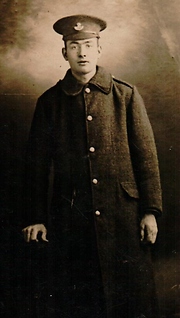 Donated by Mr. Paul Colin Hodgson
Donated by Mr. Paul Colin HodgsonThomas Hodgson, of 2 South End, Seaton Carew, served with the 8th Durham Light Infantry during the First World War.
More detail » Tipperary Clubs
Tipperary Clubs
Tipperary clubs, such as this one in Lynn Street, West Hartlepool, named after the much loved song, 'it's a long way to Tipperary', were formed during the first world war. Soldiers were billeted in various building such as schools, baths, workhouses, skating rinks, the Town Hall, hotels, and private houses throughout the Hartlepool area before going to the front. These 'Tipperary Clubs' were set up to provide comforts for the troops before they embarked. Sir William Gray provided a piano and the Boy's Brigade provided a billiard table. Writing materials, books, magazines and papers were made available to the troops as well as whist drives, concerts and suppers.
Tipperary Clubs seem to have been peculiar to Hartlepool as I can find no mention of them elsewhere.
A typical tariff in the club would be:-
Cup of coffee ½d
Cup of Cocoa ½d
Cup of tea ½d
A bottle of mineral water 3d
two slices of bread and butter 2d
Buttered Bun 1½d
Buttered Scone 1½d
Cake 1d
Salmon sandwich 3d
Three biscuits 1d
More detail » Two soldiers playing a board game in a Tipperary Club
Two soldiers playing a board game in a Tipperary Club
 Donated by Hartlepool Library Service
Donated by Hartlepool Library ServiceTwo soldiers playing a board game during WW1. They are in a Tipperary club in Lynn Street, Hartlepool.
HHT&N 527
More detail » William Henderson
William Henderson
 Created by unknown
Donated by Mr. Billy Henderson
Created by unknown
Donated by Mr. Billy HendersonA portrait photograph of William Henderson in his First World War uniform. The spurs and riding crop would suggest he was in a cavalry regiment.
More detail »




